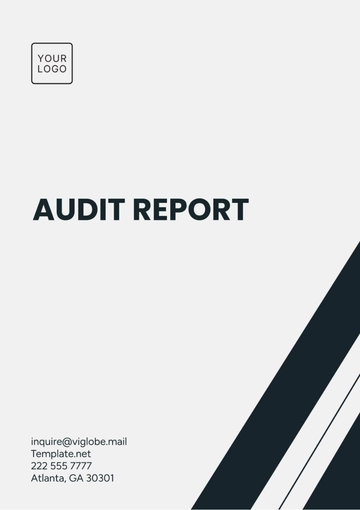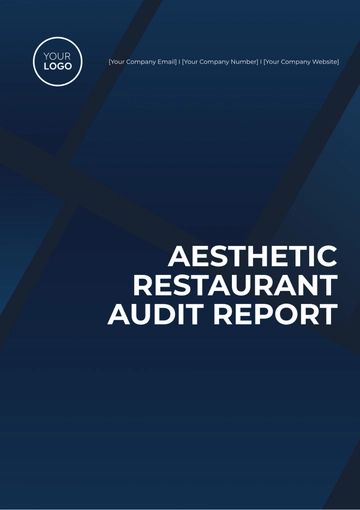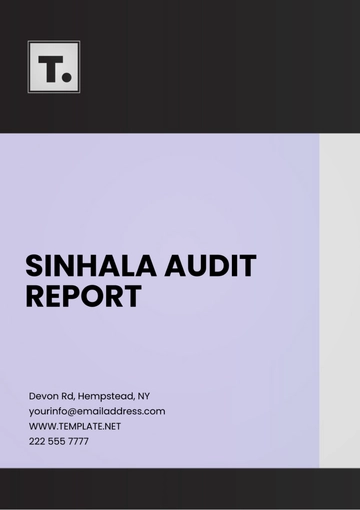Free Bookkeeping Audit Report

Audit Date: [October 9, 2050]
Reporting Period: [January 1, 2050] – [September 30, 2050]
I. Executive Summary
The purpose of this report is to provide a comprehensive review of the bookkeeping and accounting practices of [Your Company Name] for the period between [January 1, 2050] and [September 30, 2050]. This audit has been conducted to ensure that the financial statements are accurate, complete, and in compliance with accounting standards and statutory requirements. The audit was initiated to assess the overall health of the company’s financial systems, identify any areas for improvement, and provide actionable recommendations for enhancing the effectiveness of financial reporting.
The key objectives of this audit were:
To verify the accuracy of financial records by comparing them to supporting documents.
To evaluate the effectiveness of internal controls and identify any weaknesses that could lead to errors or fraud.
To ensure compliance with statutory requirements and industry standards to avoid potential legal issues.
To identify any discrepancies or misstatements in the financial records, which could affect decision-making processes.
After thoroughly analyzing the bookkeeping system and financial records, it was concluded that while most records were maintained accurately, some issues, such as minor inconsistencies in expense categorization and delayed invoice payments, were noted. Recommendations have been provided in this report for corrective actions to address these findings.
II. Audit Scope and Methodology
A. Audit Scope
The audit encompassed a review of the following areas:
Cash Flow Statements
Verification of cash receipts, payments, and reconciliation of cash balances to ensure that the company has sufficient liquidity to meet its obligations.Accounts Receivable
Review of invoices issued, outstanding receivables, and aging of accounts to assess the effectiveness of the collection process.Accounts Payable
Verification of vendor invoices, payments, and aging of payables to ensure timely payments to suppliers and maintain good relationships.Payroll Records
Examination of payroll disbursements, tax withholdings, and employee benefits to ensure compliance with labor laws and accurate employee compensation.General Ledger
Analysis of general ledger accounts to ensure accurate classification of income, expenses, assets, and liabilities, facilitating meaningful financial reporting.Bank Reconciliation
Reconciliation of bank statements with company records to identify any discrepancies between cash transactions recorded and bank balances.Financial Statements
Examination of balance sheets, income statements, and cash flow statements to provide a complete view of the company’s financial health.
B. Methodology
The audit followed a systematic approach, which included the following steps:
Sampling
A random sample of [500] transactions from each category (receipts, payments, payroll, etc.) was selected for detailed review. This sample size represents [10%] of the total transactions processed during the period under review, ensuring that a broad spectrum of the company's financial activities was evaluated.Document Review
Source documents such as invoices, receipts, bank statements, and payroll records were examined for accuracy, completeness, and compliance with the company’s internal policies. This step is crucial for validating the transactions recorded in the financial system.Analytical Procedures
Trend analysis and ratio analysis were used to identify any anomalies or irregularities in the financial data. For instance, significant fluctuations in revenues or expenses were closely examined to determine their causes.Reconciliations
Bank reconciliation statements were reviewed to confirm that balances matched the financial records. Discrepancies were investigated and documented.
III. Detailed Findings
A. Cash Flow Statements
Overview
The cash flow statement for the period showed a net inflow of [$200,000], with total cash receipts amounting to [$1,000,000] and total cash payments totaling [$800,000]. The breakdown of cash inflows and outflows is critical for understanding the company’s liquidity and operational efficiency.Category
Amount ($)
Cash Inflows
[$1,000,000]
Cash Outflows
[$800,000]
Net Cash Flow
[$200,000]
Findings
There were no significant discrepancies in the cash flow statement. However, minor delays were noted in recording certain cash receipts, which caused temporary misalignment in cash flow projections. Specifically, [5] cash receipts totaling [$15,000] were recorded with a delay of more than [7] days, affecting cash availability.Recommendations
It is recommended to implement real-time cash recording systems to avoid delays in updating the cash flow records. Automation of cash receipt entries would ensure timely and accurate reporting.
B. Accounts Receivable
Overview
The total outstanding receivables as of [September 30, 2050] amounted to [$150,000]. The aging analysis of receivables showed that:Age Bracket
Amount Outstanding ($)
Percentage (%)
0-30 Days
[$100,000]
[66.67%]
31-60 Days
[$30,000]
[20%]
61-90 Days
[$15,000]
[10%]
Over 90 Days
[$5,000]
[3.33%]
Findings
The accounts receivable aging report indicates that a significant portion of receivables is within the [0-30] days category. However, [$5,000] worth of receivables are overdue by more than [90] days, which may impact cash flow if not collected promptly. Additionally, the company experienced an increase in the average collection period from [45] days to [60] days, signaling potential inefficiencies in the collection process.Recommendations
It is advised to implement stricter collection policies for overdue accounts. Sending reminders to clients at the [45]-day mark and considering interest penalties for overdue invoices would help improve receivables turnover. Regular follow-ups and establishing payment plans for clients facing difficulties could further enhance collections.
C. Accounts Payable
Overview
As of [September 30, 2050], the total outstanding payables amounted to [$120,000]. The aging report for payables is summarized below:Age Bracket
Amount Outstanding ($)
Percentage (%)
0-30 Days
[$90,000]
[75%]
31-60 Days
[$20,000]
[16.67%]
61-90 Days
[$7,000]
[5.83%]
Over 90 Days
[$3,000]
[2.5%]
Findings
The majority of payables fall within the [0-30] days category, reflecting healthy payment practices. However, [$3,000] in payables have been outstanding for more than [90] days. Delays in processing these payments could impact relationships with vendors. Additionally, an increase in the average payment period from [30] days to [45] days was noted, suggesting a potential slowdown in cash outflows.Recommendations
It is recommended to prioritize payment of overdue invoices and streamline the approval process for vendor payments to prevent future delays. Setting up a calendar for payment schedules can ensure timely disbursements and maintain good relationships with suppliers.
D. Payroll Records
Overview
Payroll expenses for the period totaled [$400,000], which included salaries, bonuses, and employee benefits. The breakdown of payroll expenses is as follows:Expense Type
Amount ($)
Salaries
[$300,000]
Bonuses
[$70,000]
Employee Benefits
[$30,000]
Findings
A review of payroll records revealed that all employees were paid on time, and the necessary tax withholdings were made. However, there were some inconsistencies in recording employee bonuses, which led to a slight overstatement of payroll expenses by [$2,500]. This discrepancy was primarily due to improper documentation of performance-related bonuses for a few employees.Recommendations
A clearer system for tracking bonuses and their allocation is needed to ensure accurate payroll reporting. This can be achieved by integrating bonus payments directly into the payroll system rather than recording them manually. Additionally, regular audits of payroll records will help identify inconsistencies before they become significant issues.
E. General Ledger
Overview
The general ledger was reviewed for the accuracy of account classifications. A total of [5,000] transactions were posted during the audit period. Each transaction was examined to verify that it was accurately categorized and recorded.Findings
While the majority of transactions were accurately classified, there were [20] instances where expenses were incorrectly categorized. For example, [$10,000] in travel expenses were mistakenly recorded as office supplies. Such errors can lead to misstatements in financial reports and misguide management decisions.Recommendations
It is recommended that a quarterly review of the general ledger be conducted to identify and rectify any misclassifications. Training sessions for bookkeeping staff can also be beneficial to improve understanding of proper classification standards. Additionally, the introduction of automated categorization tools could minimize human error.
F. Bank Reconciliation
Overview
Bank reconciliations were performed monthly, confirming that the bank statements aligned with the company’s cash balance. The cash balance as of [September 30, 2050] was [$220,000].Findings
The reconciliation process was generally well-executed; however, discrepancies were noted in [2] instances, totaling [$5,000]. These discrepancies arose from outstanding checks that had not yet cleared, resulting in temporary misalignments between the cash records and bank statements.Recommendations
Regular communication with banks regarding outstanding checks can help clarify any discrepancies. Establishing a cutoff period for outstanding checks will also streamline the reconciliation process, ensuring that financial statements accurately reflect cash balances.
IV. Financial Statements Analysis
A. Income Statement
Overview
The income statement for the period indicated total revenues of [$1,500,000] and total expenses of [$1,275,000], resulting in a net profit of [$225,000]. This reflects a profit margin of [15%], which is considered healthy for the industry.Category
Amount ($)
Total Revenues
[$1,500,000]
Total Expenses
[$1,275,000]
Net Profit
[$225,000]
Findings
Revenue growth of [10%] was observed compared to the previous period. The increase in revenue was primarily driven by new customer acquisitions and expanded service offerings. Operating expenses increased by [5%], predominantly due to higher payroll and marketing costs.Recommendations
It is recommended to continue monitoring expense growth closely and to develop a budget that aligns with the revenue forecast. Implementing cost-control measures will help maintain or improve profit margins.
B. Balance Sheet
Overview
As of [September 30, 2050], the balance sheet showed total assets of [$1,000,000], total liabilities of [$500,000], and total equity of [$500,000]. The debt-to-equity ratio is [1:1], indicating a balanced approach to financing through both debt and equity.Category
Amount ($)
Total Assets
[$1,000,000]
Total Liabilities
[$500,000]
Total Equity
[$500,000]
Findings
The company’s financial position appears strong, with a solid asset base and manageable liabilities. However, liquidity ratios indicate a current ratio of [2:1], suggesting that the company is well-positioned to meet short-term obligations.Recommendations
To further enhance financial stability, it is recommended to consider reinvesting a portion of profits back into the business to strengthen the asset base and reduce dependency on debt financing.
C. Cash Flow Statement
Overview
The cash flow statement revealed that the primary sources of cash were from operating activities, contributing [$250,000] to net cash flow, while investing and financing activities yielded a net outflow of [$50,000].Cash Flow Category
Amount ($)
Operating Activities
[$250,000]
Investing Activities
[-$30,000]
Financing Activities
[-$20,000]
Net Cash Flow
[$200,000]
Findings
The positive cash flow from operating activities indicates effective revenue generation. However, the cash outflows in investing activities were attributed to capital expenditures for new equipment, which may enhance future productivity.Recommendations
Future cash flow projections should account for expected expenditures to ensure that the company can sustain operations without liquidity issues. Implementing cash flow forecasting tools will help anticipate cash requirements.
V. Key Trends
A. Revenue Growth
The company experienced a notable revenue growth of [10%] compared to the previous year, resulting from various strategic initiatives such as targeted marketing campaigns and diversification of services offered. This positive growth trajectory is expected to continue, providing opportunities for expansion and increased market share.
B. Expense Control
Operating expenses saw a moderate increase of [5%], primarily driven by higher payroll costs associated with increased staffing and expanded operations. Despite this rise, the net profit margin remained robust at [15%], which is a positive indicator of the company's operational efficiency.
C. Accounts Receivable Trends
The average collection period has shown a concerning increase from [45] days to [60] days, highlighting a potential need for tighter credit policies and more proactive collection efforts. The percentage of overdue receivables is relatively low, but attention should be paid to maintain effective cash flow.
D. Accounts Payable Trends
The company has maintained a healthy payables turnover ratio, but an increasing trend in the average payment period from [30] days to [45] days suggests that the company may be taking longer to pay its suppliers, which could impact relationships.
VI. Conclusion and Recommendations
Based on the findings of the bookkeeping audit, [Your Company Name] has generally maintained accurate and complete financial records. The following key recommendations are provided to further enhance financial management practices:
Improve Cash Flow Management
Implement real-time systems for cash recording and prioritize the collection of overdue receivables. A structured approach to cash flow forecasting will also help in anticipating cash needs.Strengthen Internal Controls
Segregate duties within the accounts payable department to reduce the risk of fraud and errors. Establishing approval hierarchies for expense disbursements will enhance accountability.Enhance Compliance Procedures
Set up automated tax remittance systems to ensure timely payments and avoid penalties. Regular training on compliance issues for accounting staff will further mitigate risks.Regular General Ledger Reviews
Conduct quarterly reviews of general ledger accounts to identify and rectify any misclassifications. This can be supplemented by automated classification tools to minimize human errors.Regular Training and Development
Invest in ongoing training for bookkeeping staff to keep them updated on best practices and regulatory changes, ensuring that the team remains knowledgeable and competent.Utilize Technology for Automation
Consider investing in advanced accounting software that integrates various financial functions, streamlining the bookkeeping process and improving accuracy.
By implementing these recommendations, [Your Company Name] can improve the accuracy and efficiency of its bookkeeping processes and ensure continued compliance with regulatory requirements.
- 100% Customizable, free editor
- Access 1 Million+ Templates, photo’s & graphics
- Download or share as a template
- Click and replace photos, graphics, text, backgrounds
- Resize, crop, AI write & more
- Access advanced editor
Ensure compliance and transparency with the Bookkeeping Audit Report Template from Template.net. This editable and customizable template provides a structured format for documenting audit findings, recommendations, and action plans. Use our Ai Editor Tool to tailor it to your organization, ensuring thoroughness and professionalism in your auditing processes.
You may also like
- Sales Report
- Daily Report
- Project Report
- Business Report
- Weekly Report
- Incident Report
- Annual Report
- Report Layout
- Report Design
- Progress Report
- Marketing Report
- Company Report
- Monthly Report
- Audit Report
- Status Report
- School Report
- Reports Hr
- Management Report
- Project Status Report
- Handover Report
- Health And Safety Report
- Restaurant Report
- Construction Report
- Research Report
- Evaluation Report
- Investigation Report
- Employee Report
- Advertising Report
- Weekly Status Report
- Project Management Report
- Finance Report
- Service Report
- Technical Report
- Meeting Report
- Quarterly Report
- Inspection Report
- Medical Report
- Test Report
- Summary Report
- Inventory Report
- Valuation Report
- Operations Report
- Payroll Report
- Training Report
- Job Report
- Case Report
- Performance Report
- Board Report
- Internal Audit Report
- Student Report
- Monthly Management Report
- Small Business Report
- Accident Report
- Call Center Report
- Activity Report
- IT and Software Report
- Internship Report
- Visit Report
- Product Report
- Book Report
- Property Report
- Recruitment Report
- University Report
- Event Report
- SEO Report
- Conference Report
- Narrative Report
- Nursing Home Report
- Preschool Report
- Call Report
- Customer Report
- Employee Incident Report
- Accomplishment Report
- Social Media Report
- Work From Home Report
- Security Report
- Damage Report
- Quality Report
- Internal Report
- Nurse Report
- Real Estate Report
- Hotel Report
- Equipment Report
- Credit Report
- Field Report
- Non Profit Report
- Maintenance Report
- News Report
- Survey Report
- Executive Report
- Law Firm Report
- Advertising Agency Report
- Interior Design Report
- Travel Agency Report
- Stock Report
- Salon Report
- Bug Report
- Workplace Report
- Action Report
- Investor Report
- Cleaning Services Report
- Consulting Report
- Freelancer Report
- Site Visit Report
- Trip Report
- Classroom Observation Report
- Vehicle Report
- Final Report
- Software Report





























